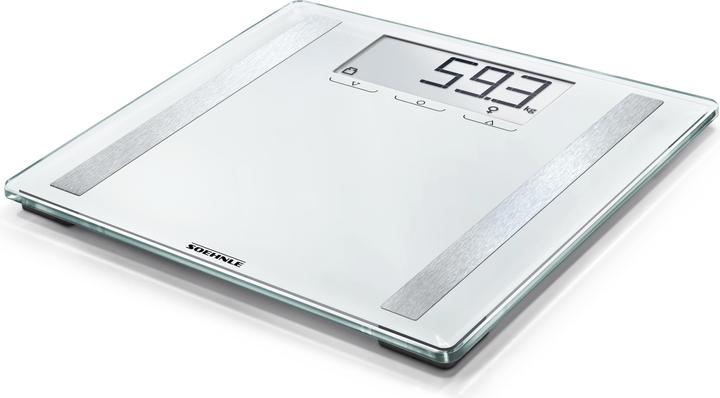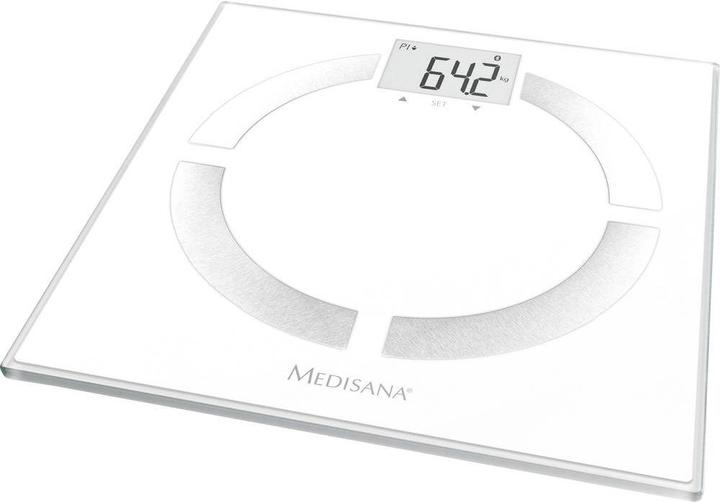

How accurate are body fat scales designed for home use?
People commonly use weight and body mass index (BMI) as indicators of whether they’re underweight, overweight or an ideal weight. It’s a pretty outdated way of doing things. After all, you need to know your body composition for these measurements to have any meaning. These days, many scales are supposedly able to measure this. I’ve tested and compared four of them – with sobering results.
Hi, I’m Oliver and I’ve been trying to adopt a healthier lifestyle for six months now. As part of this, I’ve started working out regularly, and have analysed and changed my diet. Six months ago, I tipped the scales at 84.3 kilogrammes. As I’m 177 centimetres tall, that would’ve given me a body mass index (BMI) of 26.97. According to the WHO table, that’s 0.03 points away from «overweight». But BMI only tells half the story. In theory, I could just be really muscular, with most of my weight comprised of muscle mass. With this in mind, I was keen to find out my body composition. In other words, the percentage of my body made up of fat, muscle mass, water and bone.
Apparently, you can get these measurements using body fat scales made by brands such as Garmin, Breuer, Withings and Soehnle. Not only that, but you can do it at home – easily and without any fuss. The scales will either set you back a little (30–50 francs) or a lot (over 300 francs). However, I’d already heard and read that these scales would deliver anything but correct measurements.
So, what did I do? I got myself four different body composition scales. Two were sent to me directly by the manufacturers and two came from Galaxus’s warehouses.
These are the four models I used to weigh and measure my body:
Bioelectrical impedance analysis
To test whether these four scales were accurate, I needed reference values first. To get them, I had my body composition measured by the Centre for Nutritional Medicine «Zentrum für Ernährungsmedizin» (Zermed) in Winterthur (website in German) using bioelectrical impedance analysis (BIA). This involves sending a weak electrical impulse through the body, which, based on the resistance it encounters from fat, water, muscle and bone, is used to determine the percentage of each within the body. The process works by way of a very large, very expensive scale – and not one with a small base plate. In fact, the device is big enough to accommodate the height of an adult man. It conducts the electrical current through the body via several entry and exit points (in your feet and hands).
The body fat scales in our range use a much more simplified version of this measuring method. They send a weaker current through the body, and only use one entry and exit point (in and out through the feet). One exception is the Withings scale I tested, which has hand grips and therefore promises more precise readings. It’s also the most expensive model by far.
Data, data, data
Let’s move on to the measurements. When I had my body composition professionally analysed at Zermed, these were the figures they came up with:
- Weight: 84.3 kg
- BMI: 27
- Fat mass: 23.33 kg
- Bone mass: no information
- Water: 44.67 kg
- Muscle mass: 30.23 kg
This data gave me a reference point, which I then used to calculate how much each test scale deviated. I took all the measurements about two hours after eating, drinking or going to the bathroom so that the scales would each be weighing the same «material».
Comparing the stats
Assuming the professional measurement comes closest to reflecting reality, I’ve looked at the data on weight, muscle mass, fat mass and water quantity displayed by my range of household scales. For each figure, I’ve awarded or deducted points per scale, depending on the performance.
Weight
In this category, my four test devices deviated from the reference figure by a maximum of 0.4 kg. The Garmin scale was the only one to match it exactly. In a somewhat surprising twist of events, the most expensive scale of the bunch (the Withings scale) deviated the most by far from the reference figure. When it comes to household use, none of these deviations would bother me. Especially when you consider that I’m neither a supermodel nor a martial artist trying to stick to a specific weight class. Besides, if I step onto the scales every day, my measured weight constantly varies by a few hundred grammes anyway.
Points:
- Garmin: 1
- Beurer: 0
- Withings: -1
- Xiaomi: 0
BMI
Since body mass index is dependent on body weight, which was measured differently by the scales, I expected these results would deviate from my reference figure. That’s why three of the four results are surprising, even though they only differ by tenths. Despite matching my reference figure for weight, the Garmin scale calculated a higher BMI. Meanwhile, both the Beurer and Xiaomi scales recorded my BMI as 27 (matching the reference figure) despite displaying my body weight as higher. The Withings model performed best in this category, calculating the correct BMI based on my weight.
Points:
- Garmin: -1
- Beurer: -1
- Withings: 1
- Xiaomi: -1
Muscle mass in kg
This is where the data becomes relevant to my overall health. Rather than just the heaviness of my body, it’s my body composition that really holds weight (pun intended) in this calculation. At first glance, the graph clearly shows the Withings scale deviates massively from the other results. However, this isn’t down to the measurement being way off. Instead, it’s a different interpretation of the measured data. While water contained in my muscles was deducted from my muscle mass score in my reference assessment and by the three other scales, the Withings scale includes water in my muscle mass figure. As a result, it’s impossible to do a direct comparison with the reference figure. Garmin and Beurer each display my muscle mass as around 3 kg above the reference figure. Meanwhile, the Xiaomi scale doesn’t measure muscle mass.
Points:
- Garmin: -1
- Beurer: -1
- Withings: 0
- Xiaomi: no data
Water in kg
At this point, interpreting the data gets even trickier. Although the Withings scale doesn’t display the highest water content, it’s still higher than the reference figure. The Garmin model measured, or rather calculated, an even higher amount of water, whereas the Beurer scale came up with a slightly lower number than the reference figure. However, I simply can’t judge which one measured and calculated most accurately relative to the others. The simple fact is that they all deviate significantly from the reference figure, so you should take all these results with a pinch of salt.
Points:
- Garmin: -1
- Beurer: -1
- Withings: -1
- Xiaomi: no data
Fat mass in kg
Alongside muscle mass, fat mass is a key health indicator. In combination, these figures say more about your weight and health than BMI. Incidentally, this is where all three test scales falter. Plus, the Xiaomi scale doesn’t actually measure fat mass. All of the scales I tested display figures that are obviously too low compared to my reference point. Once again, the priciest scale (the Withings) was the worst performer, coming up short by almost 6 kg in fat mass. Garmin and Beurer were short by around 3 kg.
Points:
- Garmin: -1
- Beurer: -1
- Withings: -2
- Xiaomi: no data
Looking at all five sets of figures together, here’s how the four scales compared.
Ranking:
- Garmin: -3
- Beurer: -4
- Withings: -3
Xiaomi: -2 (excluded from the ranking)
I’ve rated the Withings model lower than the Beurer BF 720 because its hefty price tag works against it. I’ve also kicked the Xiaomi scale out of the rankings because it doesn’t measure enough aspects of body composition.
How consumer issues website «Stiftung Warentest» tested body composition scales
As luck would have it, «Stiftung Warentest» (StiWa) was also putting together a body fat scale comparison while I was writing this guide. You can find its review (in German, behind a pay wall) here.
To sum it up, StiWa put 17 scales under the microscope. Eleven had an integrated app, six didn’t. However, the Xiaomi scale was the only one that strictly required the app in order to work. We sell 15 of the scales StiWa tested. The publication assessed them based on five criteria: weighing, body analysis (which together accounted for 50 per cent of the final score), ease of use, safety, durability and data protection (for the scales with an app). For the weighing and body analysis criteria, a BIA was conducted on 30 volunteers to create a reference point.
None of the scales tested received a «very good» rating. Nine were rated as «good», seven «satisfactory» and one «requires improvement». StiWa concluded that the best results don’t come from the most expensive scales. On the contrary, the two Withings scales came out worst in the review, with Beurer’s inexpensive models ranking among the winners.
Scales rated «good»
Scales rated «satisfactory»
Scales rated «requires improvement»
Verdict
I’m not really surprised that these body fat scales come up with inaccurate results when compared to the scientific measurement method. It’s to be expected that relatively cheap scales have technical limitations. However, this makes the Withings scale all the more disappointing. Its supposedly superior, hand-grip-based measuring method and correspondingly higher price tag meant it should’ve outperformed the competition. The fact that it can do an ECG (electrocardiogram, a measurement of heart rhythm and frequency) and measure nerve health and vascular age doesn’t do it any favours given how inaccurate it is on body composition. Not only because I wouldn’t be able to rely on the results, but also because I’d only ever want these readings to be carried out scientifically, with guidance from a medical professional.
The impression I got during my review is supported by extensive test results published by «Stiftung Warentest».
My recommendation
So, can I recommend one of these body fat scales based on my findings?
Yes and no. It depends what exactly you want to measure and what your goal is. If you just want to maintain your weight or lose a few kilos, an ordinary set of scales without all the bells and whistles will do the job. The problem is that scales like these are hard to come by these days. Even so, there are simple devices out there that’ll meet your needs without breaking the bank. The Xiaomi Smart Scale 2 is inexpensive and didn’t deviate much from my reference weight. However, if you want to get an idea of your body composition with at least some semblance of accuracy, you still don’t need to fork out very much. Although the Beurer BF 720 doesn’t measure with scientific precision (which is probably to your benefit), it’s significantly cheaper and only marginally less accurate than the Garmin and Withings scales.
If you’re just comparing figures over time to see how your body’s developing, the slight deviations don’t matter too much.
If, on the other hand, you want really accurate values, getting a professional measurement is the only thing for it. My first measurement, including a consultation and explanation of the data, cost me 50 francs, with each additional measurement costing 30 francs.
All this considered, I’ll be sticking with my who-knows-how-old Soehnle scale (no longer available to buy) for household use. I’ll also treat myself to a professional measurement once or twice a year.
Globetrotter, hiker, wok world champion (not in the ice channel), word acrobat and photo enthusiast.
Practical solutions for everyday problems with technology, household hacks and much more.
Show all

















